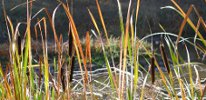
Training
Jurisdictional Delineation of Waters of the U.S., Including Wetlands On the California Coast: Legal and Ecological Protocols For Diverse and Changing Landscapes
COST: $1300.00
Payable by check to Elkhorn Slough Foundation
REGISTRATION FOR THIS PROGRAM IS CLOSED
CONTINUING EDUCATION CREDITS: 40
Instructor Information
Dr. Robert Curry
RPG Principal Geology, Hydrology and Soil Science
Watershed Systems
Dr. John Dixon
Senior Ecologist
California Coastal Commission
Dr. Peggy Fiedler
Consulting Botanist & Conservation Ecologist
Dr. Andrew Harley
Principal
R Squared Incorporated
Dr. Grey Hayes
CTP Coordinator
Elkhorn Slough Coastal Training Program
Dr. Lyndon Lee
Principal Ecologist & President
L.C. Lee & Associates, Inc.
Contact
Grey Hayes
grey@elkhornslough.org
(831) 274-8700
Sponsors
National Wetland Science Training Cooperative, a Division of WSP Environment & Energy
Description
See also: Wetland Delineation, Polluted RunoffLots has changed within the field of waters/wetland delineation in recent times, including new Supreme Court rulings and new regional manuals and criteria. On April 1-4, well known wetlands experts Drs. Lyndon Lee, Peggy Fiedler, and Robert Curry taught a course designed to address issues old and new in delineating waters/wetlands of the U.S. While most waters/wetlands delineation courses feature a single instructor with more narrow expertise, this was a rare opportunity to explore each of the three waters/wetlands delineation parameters (soils, hydrology, and vegetation) in depth with well respected experts trained specifically in each area. The course was well attended mostly by individuals from private sector consulting firms as well as by federal, state, regional, county and municipal agencies, and universities and land management organizations. This mix gave the course a great breadth of experience and perspective. The chief objective of the training was to provide participants with a comprehensive, lecture and field-based introduction to delineation of Waters of the United States, including wetlands. The technical foundations for the course was the 1987 "Corps Of Engineers Wetlands Delineation Manual, the "Interim Regional Supplement to the Corps: Arid West Region," and the "Draft Regional Supplement to the Corps Manual: Western Mountains, Valleys, and Coast Region." In order to accomplish the overall objective, specific segments of the course agenda focused on: (a) Recognition and description of hydrologic indicators of wetland conditions in California's central coast (b) Identification and characterization of hydric soils and soil-forming processes characteristic to wetland sites in central, coastal California (c) Identification and characterization of hydrophytic plant communities typical to wetlands on California's central coast (d) Synthesis of hydrologic, soils, and plant community information for jurisdictional delineation of relatively pristine as well as highly degraded wetlands in California consistent with (1) the 1987 Corps Of Engineers Wetlands Delineation Manual, (2) the "Interim Regional Supplement to the Corps: Arid West Region," (3) the "Draft Regional Supplement to the Corps Manual: Western Mountains, Valleys, and Coast Region" and (4) current federal, state (including California Coastal Commission) and local agency policies and operating procedures. (e) Field and administrative techniques for (1) documentation and/or presentation of delineations of Waters of the U.S., including wetlands, and (2) recognition and documentation of non-compliance with federal, California and local waters/wetlands protection statutes. Throughout the course, lectures and classroom exercises were combined with field trips to several different types of waters/wetland ecosystems in the vicinity of northern Monterey and southern Santa Cruz counties. Field exercises and discussions during the course focused on a range of waters/wetland types that are typical to central coastal California. Field exercises were designed to vary in difficulty from the most basic to the most difficult jurisdictional calls. Stops included estuarine tidal and freshwater marshes, riparian, vernal pools, seasonally wet meadows, slope wetlands, and filled wetlands as well as one extensively restored site. Participants worked closely with instructors to develop state-of-the-art knowledge of how to recognize and accurately map the geographic extent of Waters of the U.S, including wetlands. In particular, the course focused on how to use the 1987 Corps Of Engineers methodology for identifying and delineating jurisdictional wetlands and relationships between the 1987 Corps Manual and, the "Interim Regional Supplement to the Corps: Arid West Region," and the "Draft Regional Supplement to the Corps Manual: Western Mountains, Valleys, and Coast Region." Given the moderate size of the class (40 students total), and the collective expertise of the instructor team, participants were given a rare opportunity to hone existing wetland delineation skills and to develop and apply new skills in a course that is specifically tailored for wetlands typical to California's central coast. This was a field-based course. In this regard, a "hands-on" approach was emphasized during all phases of lecture and field instruction. Upon successful completion of the course and requisite lecture and field examinations, participants received NWSTC CERTIFICATION that documents 40+ hours of training in the use of the 1987 Corps of Engineers Wetlands Delineation Manual and the Interim Regional Supplement to the Corps: Arid West Region, and the Draft Regional Supplement to the Corps Manual: Western Mountains, Valleys, and Coast Region. We were very pleased with the course and hope to offer it again in the near future. Ask us if you want more details or have suggestions.
Documents and Publications
Links
Hydric Soils Lists
http://soils.usda.gov/use/hydric/
Interim Regional Supplement to the Corps of Engineers Wetland Delineation Manual: Western Mountains, Valleys, and Coast Region
http://www.usace.army.mil/cw/cecwo/reg/west_mt_intersupp.pdf
Interim Regional Supplement to the Corps: Arid West Region
http://www.usace.army.mil/cw/cecwo/reg/inte_aridwest_sup.pdf
National Wetland Inventory (NWI)
http://www.fws.gov/nwi/
Questions and Answers
Submit a question on this subject and we'll provide an answer. coastaltraining@elkhornsloughctp.org
